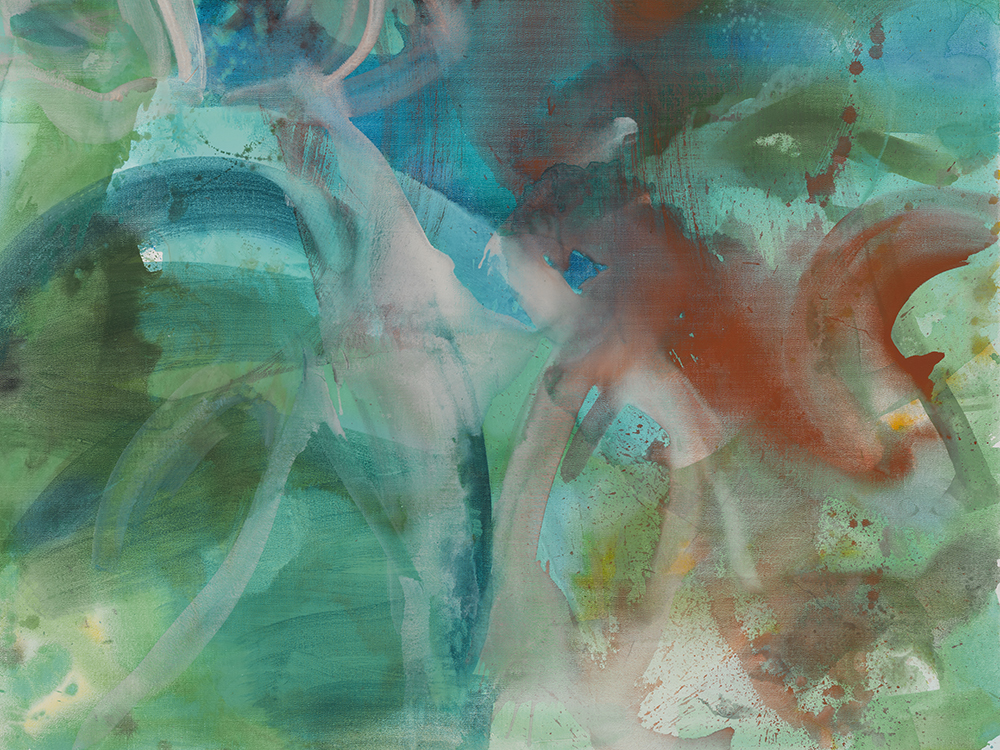Long-fascinated formally by shape, chromatic modulation, and their definition of a place and its contours, Mary Weatherford’s work has evolved into an abstract geography of incident—a geography that continues to become more expansive in every sense.
The title of her current show is “Mountains Mud Prisms Air.” Whatever the inspirational specifics, Weatherford has gone in for a deep dive. The linen surfaces are covered nearly edge to edge. Yet movement seems to animate the work as much as color. In Through the Trees (all works 2021), streaky whites slash through greens and aquamarines as if opening a piece of the sky. Working with Flashe pigments, Weatherford takes a light hand, applying color in even, transparent layers. In The Birds of Kilauea Point, pigments and brush strokes indicate wild flight before exuberant color (local seabird populations are in fact not exceptional in coloration). Here, a tube of blue neon bisects the picture plane, casting more shadow than glow on a greige mid-section, making a kind of diptych.

Mary Weatherford, Mountains Mud Prisms Air, 2021. Photo by Fredrik Nilsen Studio. Courtesy of David Kordansky Gallery, Los Angeles.
Elsewhere, Weatherford evinces a keen sense of the way art narrates an experience of nature in terms of both chromatic layering and composition—the subtle redirection and inversions of line or contour and coloration; how the interstitial event or phenomenon becomes crucial, the ‘main event’ a footnote. In Yellow Sun, for example, the sun becomes a sinking yellow ball caught beneath a snarl of madder rose and cresting amethyst passages. Or—still more willfully abstracted—consider the sun as a mere pebble lost at the center of a blurred ‘grid’ of rosy loops, hooks and arches roiling over a blue ground (Yellow Sun Far Away). Setting aside the ambitious scale of the largest works (which are mural-sized—133” x 287”), these mid-size panels are by far the most adventurous work exhibited here—not that they are uniformly successful. Air churns with indigo, cerulean, greens and scarlet, bisected by a green neon tube, but for all its technical prowess it feels more like a dress rehearsal for a section of one of the quasi-operatic mural panels—say, Below the Cliff—which makes sense if what we infer pictorially from this epic is a kind of myth composed of earth, water, fire and air; and, given that air and fire will assert their dominion on the beach and off, it does.
That the painting holds together as well as it does is almost miraculous. The similarly scaled Light Falling Like A Broken Chain; Paradise, which suspends two similar spirals, yellow and white, at the top-center of the panel, asks a bit more of the viewer, but seems to deliver less—as if buffered by a School of Paris restraint.
Weatherford includes two smaller panels with neon transversals (red and vertical for Signal; white and horizontal for Warm Weather), which both hearken back to the period immediately before and after her 2012 “Bakersfield Project” paintings (her first incorporating neon tubes) yet are clearly distinct from them—filling the panels, variegated yet slightly more monochromatic, self-contained yet richly evocative—masterpieces. Mountains and jungles are picturesque by definition; but as Weatherford knows quite well, from a cave wall one can make poetry.


